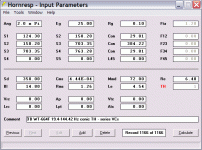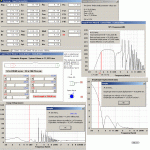Hi there.
Actually I wanted to build a fullrange speaker, but due to budget constraints, I'll just upgrade my z-5500.
This is the driver: http://www.tb-speaker.com/detail/1208_03/wt-644f.htm just with a logitech sticker on it.
I've read this forum for 2 days, but getting to the bottom of how and why which design is preffered is hard to understand.
The subs job will be to cover the range up to 100Hz.
My room is rather small and I prefer good, tight bass.
The size doesn't matter that much, if it could be used to put things (like books) on it.
I really like horndesigns, and it seems as if tapped horns are all the rave. At the moment I'm playing around with hornresp, but I'm mostly clueless.
Do you have any suggestions? Any favoured enclosures based on the driver?
Thanks 🙂.
Lifthanger
Actually I wanted to build a fullrange speaker, but due to budget constraints, I'll just upgrade my z-5500.
This is the driver: http://www.tb-speaker.com/detail/1208_03/wt-644f.htm just with a logitech sticker on it.
I've read this forum for 2 days, but getting to the bottom of how and why which design is preffered is hard to understand.
The subs job will be to cover the range up to 100Hz.
My room is rather small and I prefer good, tight bass.
The size doesn't matter that much, if it could be used to put things (like books) on it.
I really like horndesigns, and it seems as if tapped horns are all the rave. At the moment I'm playing around with hornresp, but I'm mostly clueless.
Do you have any suggestions? Any favoured enclosures based on the driver?
Thanks 🙂.
Lifthanger
Greets!
Here's one you can fiddle with in the TH Wizard. As is, once damped it should be flat enough, though it may need a high pass (HP) to protect it below 20 Hz for movies, some pipe organ symphonies.
WinISD specs uploaded here for standard alignments. Note that the calculated Fs is somewhat lower than published, though other specs are close. Not sure why they're a bit different from Hornresp's, but they sim the same: http://www.hometheatershack.com/for...downloadable-winisd-pro-files.html#post180306
GM
Here's one you can fiddle with in the TH Wizard. As is, once damped it should be flat enough, though it may need a high pass (HP) to protect it below 20 Hz for movies, some pipe organ symphonies.
WinISD specs uploaded here for standard alignments. Note that the calculated Fs is somewhat lower than published, though other specs are close. Not sure why they're a bit different from Hornresp's, but they sim the same: http://www.hometheatershack.com/for...downloadable-winisd-pro-files.html#post180306
GM
Attachments
I managed to input the values and get into the tapped horn wizard.
But I'm not sure what I'm trying to do there. Flatten out the response between 20-100Hz?! It seems your values are very good already.
I'll have to make a filter... the displacement below 20Hz is too high.
But I'm not sure what I'm trying to do there. Flatten out the response between 20-100Hz?! It seems your values are very good already.
I'll have to make a filter... the displacement below 20Hz is too high.
.Do you have any suggestions? Any favoured enclosures based on the driver ..
Hi,
I tested the Tangband driver in HR input screen and found the T/S data not consistent, so I changed Mmd to a much lower value than GM is using in his TH suggestion and simulated a T-TQWT, shown in picture 1(1).
The T-TQWT have IMO blameless group delay at 100 Hz ( No need for signal delay the Main Speakers) and a FR curve that doesn't need to be equalized either.
b
1(1)
Hi,
I tested the Tangband driver in HR input screen and found the T/S data not consistent, so I changed Mmd to a much lower value than GM is using in his TH suggestion and simulated a T-TQWT, shown in picture 1(1).
The T-TQWT have IMO blameless group delay at 100 Hz ( No need for signal delay the Main Speakers) and a FR curve that doesn't need to be equalized either.
b
1(1)
Attachments
you obviously know what you're talking about, but I'm still new to this.
What is T-TQWT ? I only know what a TQWt is.
Unfortunately I'm still trying to understand what happens in the wizard. The taper is visible in the schematic. It also seems you already optimized the values. The T/S parameters are derived from the actual physical parameters of the driver, which is why you found inconsistencies between the moving mass and the Qms or something?
Wether the horn(?) will be folded or not, is not determined by the wizard, only the length and cross sections, the rest is up to me?
I understand the group delay part no problem, though.
thanks for your time 🙂
learned alot already.
edit: I'M trying to use a Thiele Calculator to understand your values.
Unfortunately I haven't got al clue what the added mass and Fsa are.
(or how they are calculated). The rest of the values seem fine. The inductivity is a bit high with 5.4mH.
What is T-TQWT ? I only know what a TQWt is.
Unfortunately I'm still trying to understand what happens in the wizard. The taper is visible in the schematic. It also seems you already optimized the values. The T/S parameters are derived from the actual physical parameters of the driver, which is why you found inconsistencies between the moving mass and the Qms or something?
Wether the horn(?) will be folded or not, is not determined by the wizard, only the length and cross sections, the rest is up to me?
I understand the group delay part no problem, though.
thanks for your time 🙂
learned alot already.
edit: I'M trying to use a Thiele Calculator to understand your values.
Unfortunately I haven't got al clue what the added mass and Fsa are.
(or how they are calculated). The rest of the values seem fine. The inductivity is a bit high with 5.4mH.
An externally hosted image should be here but it was not working when we last tested it.
..What is T-TQWT ? I only know what a TQWt is.Unfortunately I'm still trying to understand what happens in the wizard. The taper is visible in the schematic. It also seems you already optimized the values. The T/S parameters are derived from the actual physical parameters of the driver, which is why you found inconsistencies between the moving mass and the Qms or something?Wether the horn(?) will be folded or not, is not determined by the wizard, only the length and cross sections, the rest is up to me?..
Hi Lifthanger,
A T-TQWT is short for Tapped-Tapered Quarter Wave Tube.
Your right, the taper is shown but also that if TH is invoked at the main input screen, you must fold at least once and this may shorten the speaker from L to L/2 as the driver front and rear sides are shown in the schematic.
If you bring up the TH Wizard and choose the 'Driver ' button you can consistency check your driver data by solving for fs,Qes,Qms,Qts and Vas.
At the main input screen you should always double click the driver parameters = BL,Cms, Rms and Mmd and enter the appropriate numbers while finally clicking Sd will return the usual T/S parameters = fs,Qes,Qms,Qts and Vas.
PS. Your Thiele calculator seems to use he most preferable method to determine the TS parameters.
That is by adding a known weight(extra mass = coins) attached to the driver cone in free air and measuring the new driver fs that will be of a lower frequency = fs' or in yours = fsa.
b
Thank you very much bjorno,
that cleared up a lot.
With your help and WinISD I came to these values which look very nice.
The next question is: how did you find the other values like S1,S2,L12 and so on.
There has to be a trick for that, too 🙂. I could just take your numbers, but I`d like to learn what happened here.
Just saw the picture.. the lower rows of values can be ignored.
that cleared up a lot.
With your help and WinISD I came to these values which look very nice.
An externally hosted image should be here but it was not working when we last tested it.
The next question is: how did you find the other values like S1,S2,L12 and so on.
There has to be a trick for that, too 🙂. I could just take your numbers, but I`d like to learn what happened here.
Just saw the picture.. the lower rows of values can be ignored.
The next question is: how did you find the other values like S1,S2,L12 and so on.
Thats what its all about,to test different dimensions that could suit a deign but as a start you can copy a proved deign as a template and at the main input screen by double clicking tweaking the numbers to see what happens when you change the numbers.
Rec: First read the HR help file also visit:
http://www.diyaudio.com/wiki/index.php?page=Hornresp+Help'
then do a search on 'Tapped horn for dummies' and read all the threads.
Don't forget to read:
http://www.diyaudio.com/forums/showthread.php?threadid=119854
and
http://www.diyaudio.com/forums/showthread.php?threadid=97674
b
- Status
- Not open for further replies.
- Home
- Loudspeakers
- Subwoofers
- enclosure for TB WT-644F (z-5500) 10"

